Intercultural Communication: Analysis of Cultural Values, Communication and Decision Making
VerifiedAdded on 2023/04/22
|13
|3376
|67
AI Summary
This report analyzes the role of intercultural communication in the context of Backpack Bed for Homeless, an Australian charity foundation, and its entry into Indonesia to help the country during the disaster of Tsunami. It discusses the impact of cultural values, etiquette, direct versus indirect communication, and cultural norms of decision making. The report provides recommendations for negotiating with the government, establishing clarity in messages, and involving the government through an agreement.
Contribute Materials
Your contribution can guide someone’s learning journey. Share your
documents today.
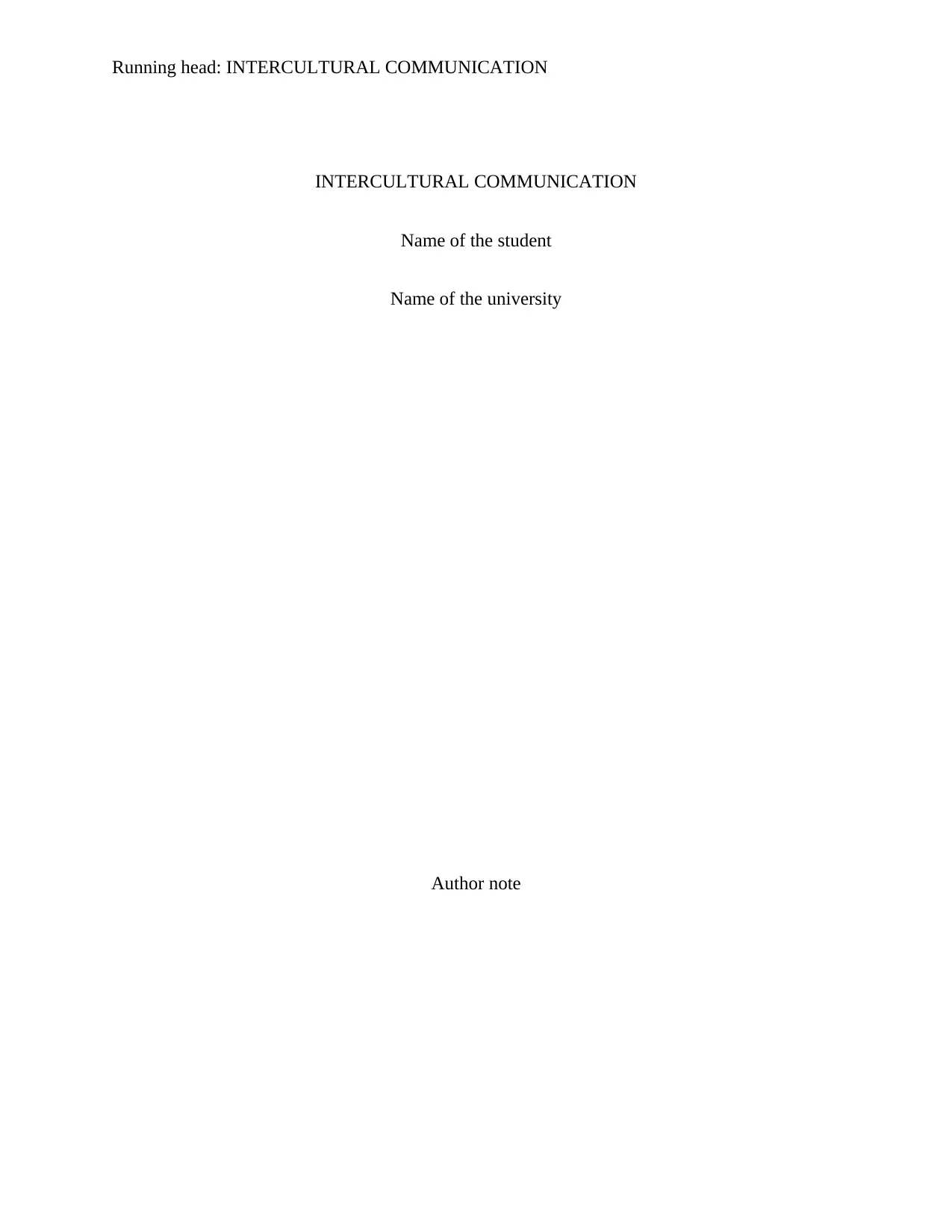
Running head: INTERCULTURAL COMMUNICATION
INTERCULTURAL COMMUNICATION
Name of the student
Name of the university
Author note
INTERCULTURAL COMMUNICATION
Name of the student
Name of the university
Author note
Secure Best Marks with AI Grader
Need help grading? Try our AI Grader for instant feedback on your assignments.
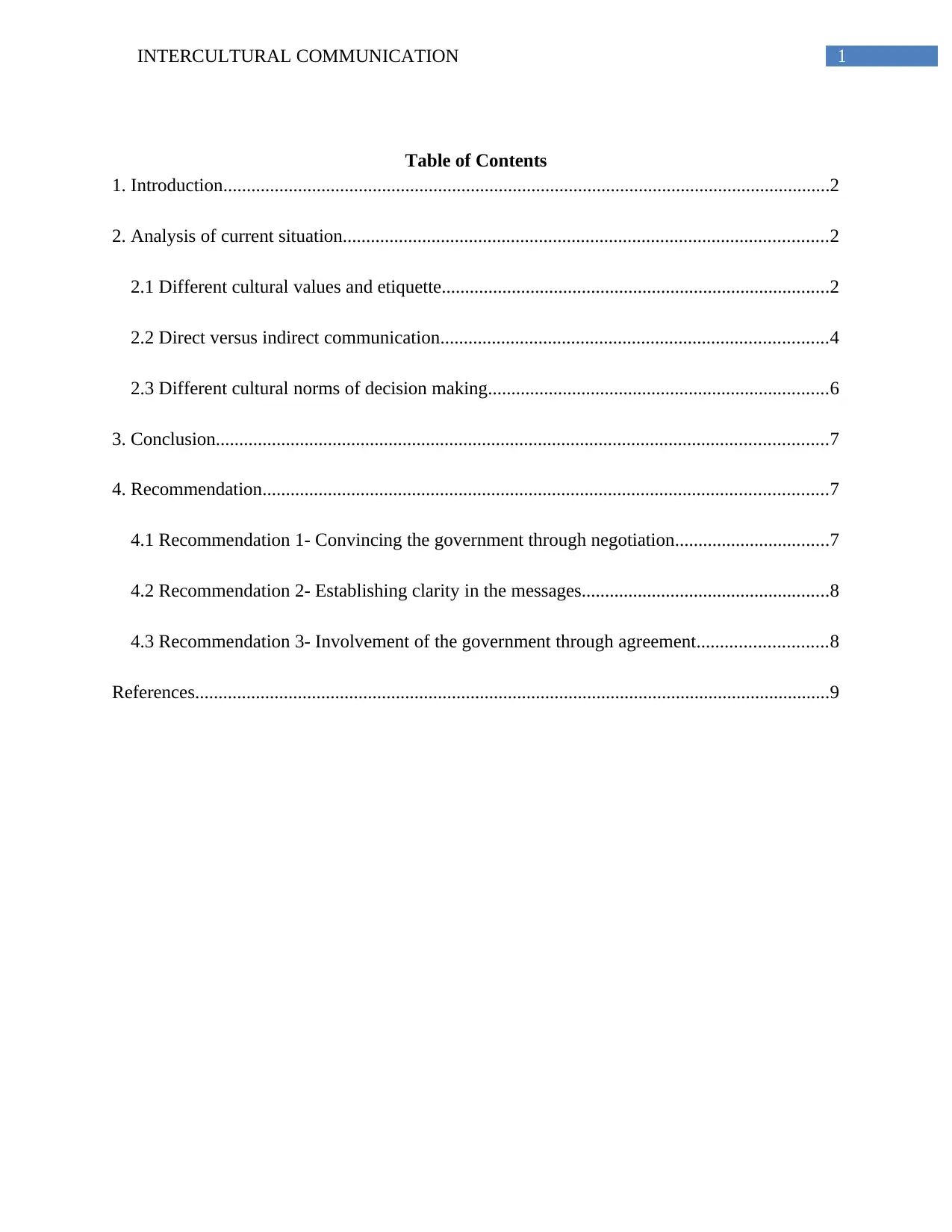
1INTERCULTURAL COMMUNICATION
Table of Contents
1. Introduction..................................................................................................................................2
2. Analysis of current situation........................................................................................................2
2.1 Different cultural values and etiquette...................................................................................2
2.2 Direct versus indirect communication...................................................................................4
2.3 Different cultural norms of decision making.........................................................................6
3. Conclusion...................................................................................................................................7
4. Recommendation.........................................................................................................................7
4.1 Recommendation 1- Convincing the government through negotiation.................................7
4.2 Recommendation 2- Establishing clarity in the messages.....................................................8
4.3 Recommendation 3- Involvement of the government through agreement............................8
References........................................................................................................................................9
Table of Contents
1. Introduction..................................................................................................................................2
2. Analysis of current situation........................................................................................................2
2.1 Different cultural values and etiquette...................................................................................2
2.2 Direct versus indirect communication...................................................................................4
2.3 Different cultural norms of decision making.........................................................................6
3. Conclusion...................................................................................................................................7
4. Recommendation.........................................................................................................................7
4.1 Recommendation 1- Convincing the government through negotiation.................................7
4.2 Recommendation 2- Establishing clarity in the messages.....................................................8
4.3 Recommendation 3- Involvement of the government through agreement............................8
References........................................................................................................................................9
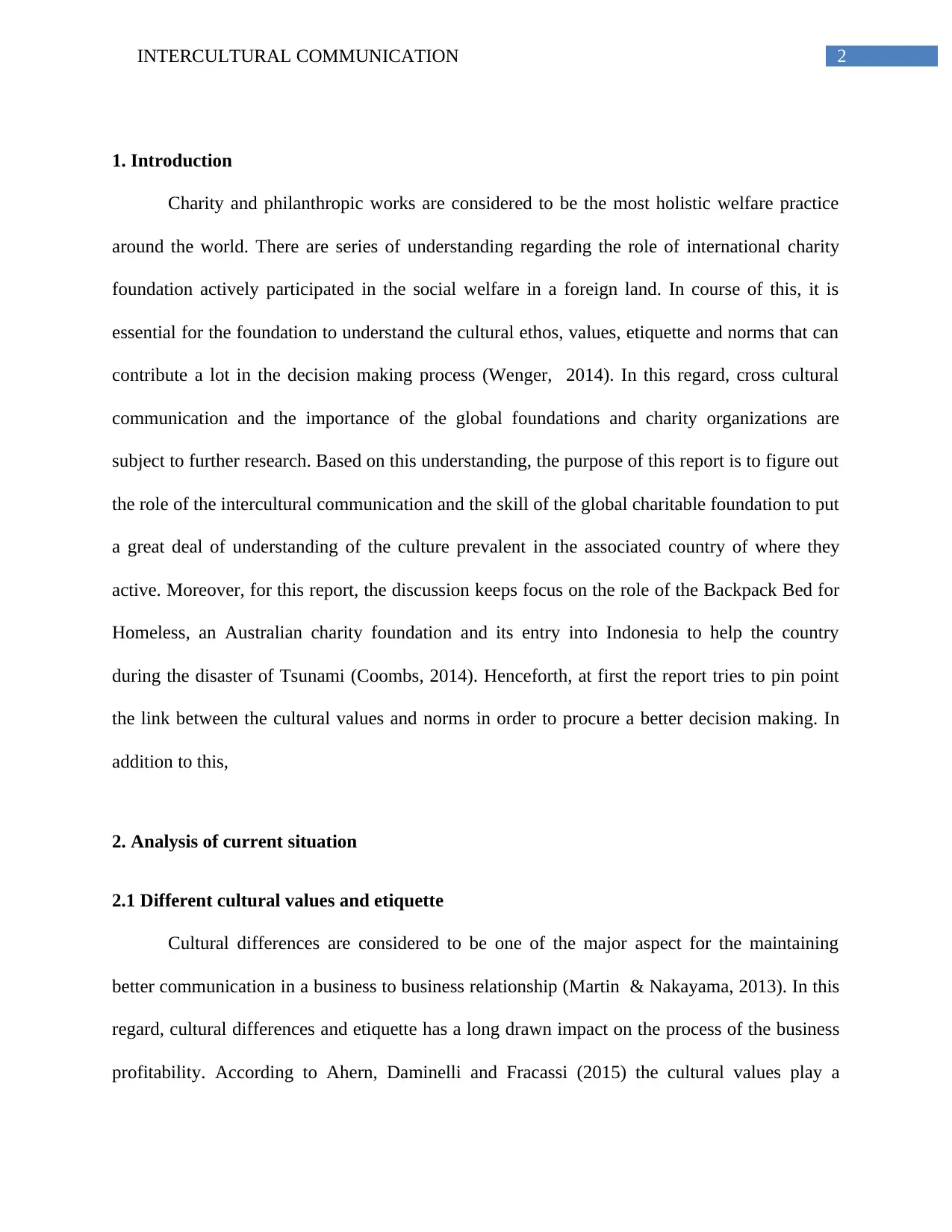
2INTERCULTURAL COMMUNICATION
1. Introduction
Charity and philanthropic works are considered to be the most holistic welfare practice
around the world. There are series of understanding regarding the role of international charity
foundation actively participated in the social welfare in a foreign land. In course of this, it is
essential for the foundation to understand the cultural ethos, values, etiquette and norms that can
contribute a lot in the decision making process (Wenger, 2014). In this regard, cross cultural
communication and the importance of the global foundations and charity organizations are
subject to further research. Based on this understanding, the purpose of this report is to figure out
the role of the intercultural communication and the skill of the global charitable foundation to put
a great deal of understanding of the culture prevalent in the associated country of where they
active. Moreover, for this report, the discussion keeps focus on the role of the Backpack Bed for
Homeless, an Australian charity foundation and its entry into Indonesia to help the country
during the disaster of Tsunami (Coombs, 2014). Henceforth, at first the report tries to pin point
the link between the cultural values and norms in order to procure a better decision making. In
addition to this,
2. Analysis of current situation
2.1 Different cultural values and etiquette
Cultural differences are considered to be one of the major aspect for the maintaining
better communication in a business to business relationship (Martin & Nakayama, 2013). In this
regard, cultural differences and etiquette has a long drawn impact on the process of the business
profitability. According to Ahern, Daminelli and Fracassi (2015) the cultural values play a
1. Introduction
Charity and philanthropic works are considered to be the most holistic welfare practice
around the world. There are series of understanding regarding the role of international charity
foundation actively participated in the social welfare in a foreign land. In course of this, it is
essential for the foundation to understand the cultural ethos, values, etiquette and norms that can
contribute a lot in the decision making process (Wenger, 2014). In this regard, cross cultural
communication and the importance of the global foundations and charity organizations are
subject to further research. Based on this understanding, the purpose of this report is to figure out
the role of the intercultural communication and the skill of the global charitable foundation to put
a great deal of understanding of the culture prevalent in the associated country of where they
active. Moreover, for this report, the discussion keeps focus on the role of the Backpack Bed for
Homeless, an Australian charity foundation and its entry into Indonesia to help the country
during the disaster of Tsunami (Coombs, 2014). Henceforth, at first the report tries to pin point
the link between the cultural values and norms in order to procure a better decision making. In
addition to this,
2. Analysis of current situation
2.1 Different cultural values and etiquette
Cultural differences are considered to be one of the major aspect for the maintaining
better communication in a business to business relationship (Martin & Nakayama, 2013). In this
regard, cultural differences and etiquette has a long drawn impact on the process of the business
profitability. According to Ahern, Daminelli and Fracassi (2015) the cultural values play a
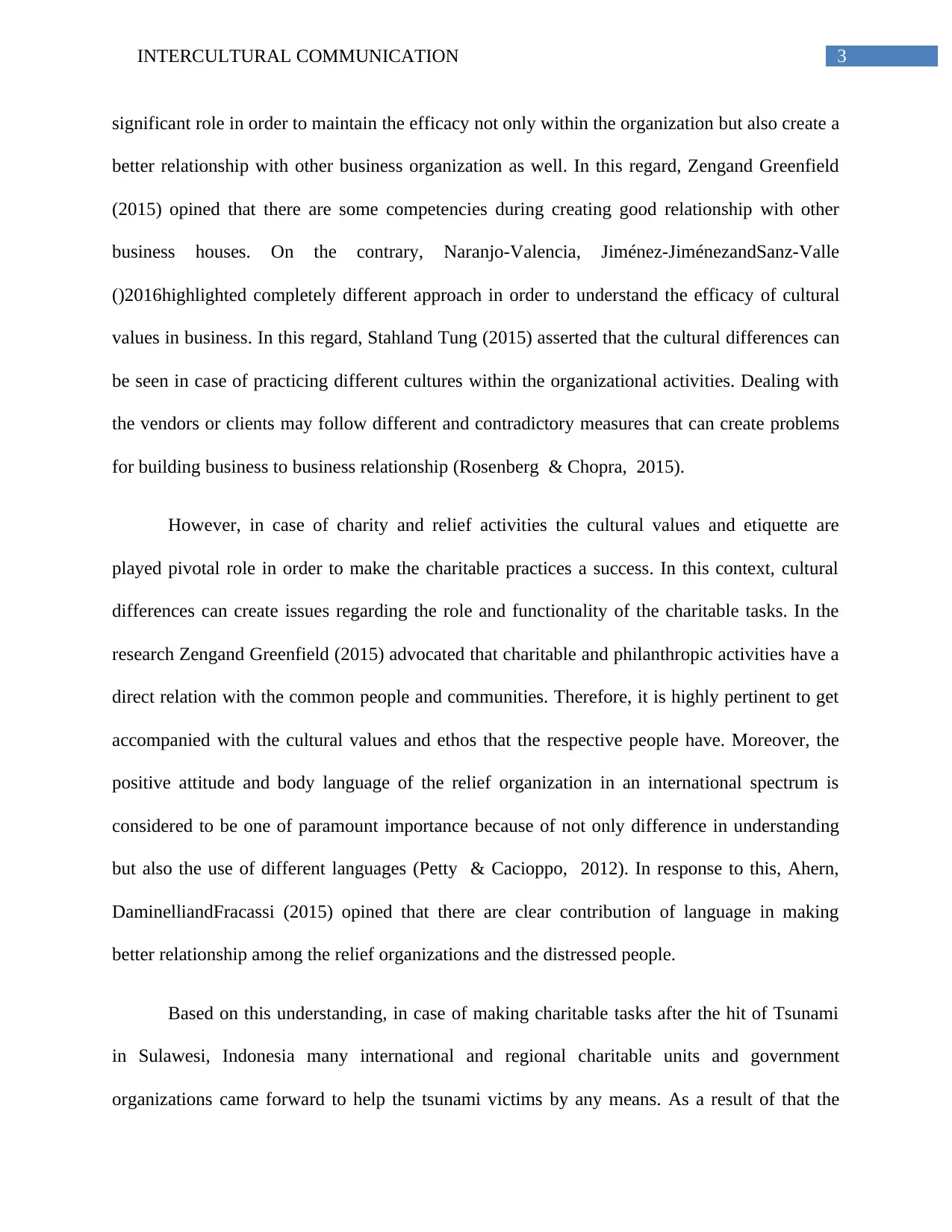
3INTERCULTURAL COMMUNICATION
significant role in order to maintain the efficacy not only within the organization but also create a
better relationship with other business organization as well. In this regard, Zengand Greenfield
(2015) opined that there are some competencies during creating good relationship with other
business houses. On the contrary, Naranjo-Valencia, Jiménez-JiménezandSanz-Valle
()2016highlighted completely different approach in order to understand the efficacy of cultural
values in business. In this regard, Stahland Tung (2015) asserted that the cultural differences can
be seen in case of practicing different cultures within the organizational activities. Dealing with
the vendors or clients may follow different and contradictory measures that can create problems
for building business to business relationship (Rosenberg & Chopra, 2015).
However, in case of charity and relief activities the cultural values and etiquette are
played pivotal role in order to make the charitable practices a success. In this context, cultural
differences can create issues regarding the role and functionality of the charitable tasks. In the
research Zengand Greenfield (2015) advocated that charitable and philanthropic activities have a
direct relation with the common people and communities. Therefore, it is highly pertinent to get
accompanied with the cultural values and ethos that the respective people have. Moreover, the
positive attitude and body language of the relief organization in an international spectrum is
considered to be one of paramount importance because of not only difference in understanding
but also the use of different languages (Petty & Cacioppo, 2012). In response to this, Ahern,
DaminelliandFracassi (2015) opined that there are clear contribution of language in making
better relationship among the relief organizations and the distressed people.
Based on this understanding, in case of making charitable tasks after the hit of Tsunami
in Sulawesi, Indonesia many international and regional charitable units and government
organizations came forward to help the tsunami victims by any means. As a result of that the
significant role in order to maintain the efficacy not only within the organization but also create a
better relationship with other business organization as well. In this regard, Zengand Greenfield
(2015) opined that there are some competencies during creating good relationship with other
business houses. On the contrary, Naranjo-Valencia, Jiménez-JiménezandSanz-Valle
()2016highlighted completely different approach in order to understand the efficacy of cultural
values in business. In this regard, Stahland Tung (2015) asserted that the cultural differences can
be seen in case of practicing different cultures within the organizational activities. Dealing with
the vendors or clients may follow different and contradictory measures that can create problems
for building business to business relationship (Rosenberg & Chopra, 2015).
However, in case of charity and relief activities the cultural values and etiquette are
played pivotal role in order to make the charitable practices a success. In this context, cultural
differences can create issues regarding the role and functionality of the charitable tasks. In the
research Zengand Greenfield (2015) advocated that charitable and philanthropic activities have a
direct relation with the common people and communities. Therefore, it is highly pertinent to get
accompanied with the cultural values and ethos that the respective people have. Moreover, the
positive attitude and body language of the relief organization in an international spectrum is
considered to be one of paramount importance because of not only difference in understanding
but also the use of different languages (Petty & Cacioppo, 2012). In response to this, Ahern,
DaminelliandFracassi (2015) opined that there are clear contribution of language in making
better relationship among the relief organizations and the distressed people.
Based on this understanding, in case of making charitable tasks after the hit of Tsunami
in Sulawesi, Indonesia many international and regional charitable units and government
organizations came forward to help the tsunami victims by any means. As a result of that the
Secure Best Marks with AI Grader
Need help grading? Try our AI Grader for instant feedback on your assignments.
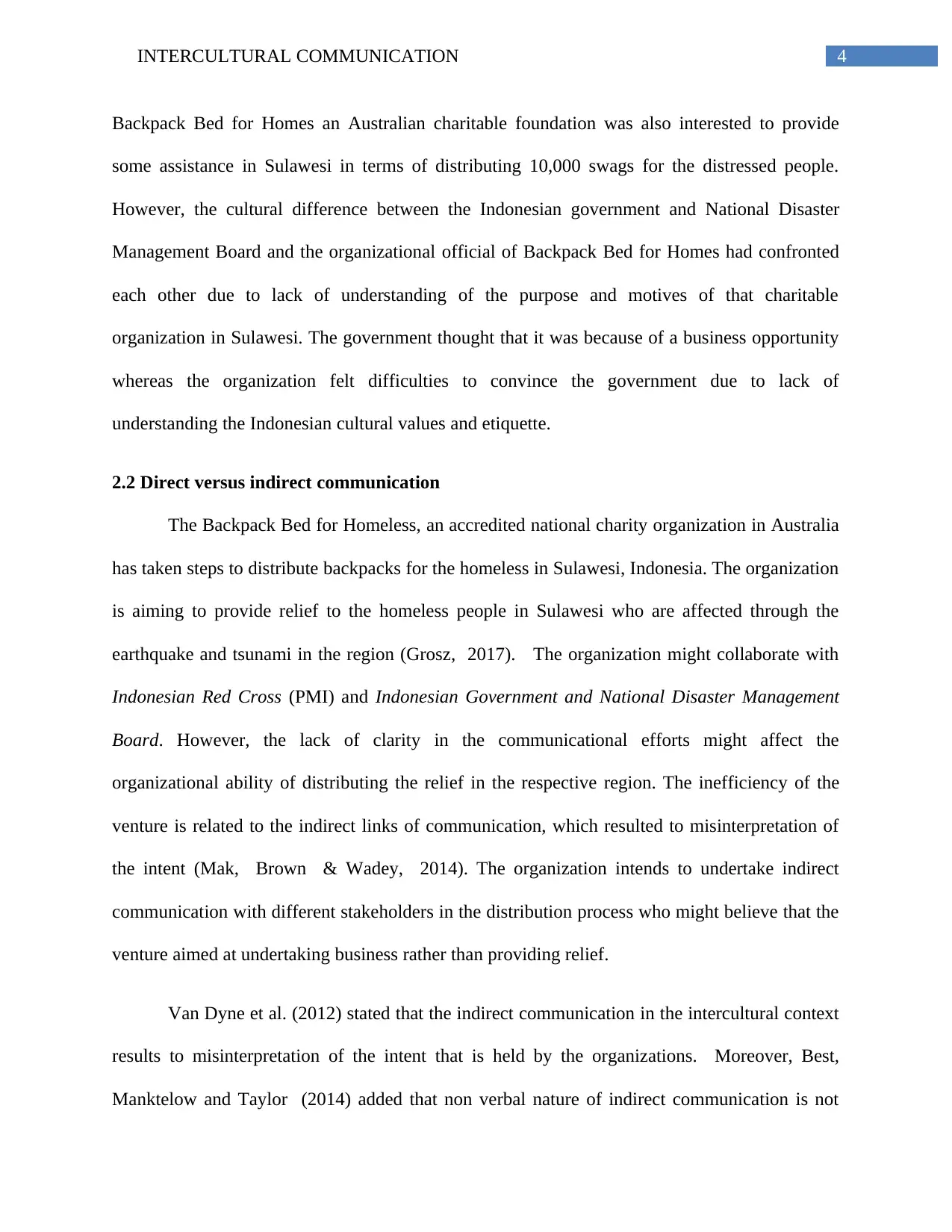
4INTERCULTURAL COMMUNICATION
Backpack Bed for Homes an Australian charitable foundation was also interested to provide
some assistance in Sulawesi in terms of distributing 10,000 swags for the distressed people.
However, the cultural difference between the Indonesian government and National Disaster
Management Board and the organizational official of Backpack Bed for Homes had confronted
each other due to lack of understanding of the purpose and motives of that charitable
organization in Sulawesi. The government thought that it was because of a business opportunity
whereas the organization felt difficulties to convince the government due to lack of
understanding the Indonesian cultural values and etiquette.
2.2 Direct versus indirect communication
The Backpack Bed for Homeless, an accredited national charity organization in Australia
has taken steps to distribute backpacks for the homeless in Sulawesi, Indonesia. The organization
is aiming to provide relief to the homeless people in Sulawesi who are affected through the
earthquake and tsunami in the region (Grosz, 2017). The organization might collaborate with
Indonesian Red Cross (PMI) and Indonesian Government and National Disaster Management
Board. However, the lack of clarity in the communicational efforts might affect the
organizational ability of distributing the relief in the respective region. The inefficiency of the
venture is related to the indirect links of communication, which resulted to misinterpretation of
the intent (Mak, Brown & Wadey, 2014). The organization intends to undertake indirect
communication with different stakeholders in the distribution process who might believe that the
venture aimed at undertaking business rather than providing relief.
Van Dyne et al. (2012) stated that the indirect communication in the intercultural context
results to misinterpretation of the intent that is held by the organizations. Moreover, Best,
Manktelow and Taylor (2014) added that non verbal nature of indirect communication is not
Backpack Bed for Homes an Australian charitable foundation was also interested to provide
some assistance in Sulawesi in terms of distributing 10,000 swags for the distressed people.
However, the cultural difference between the Indonesian government and National Disaster
Management Board and the organizational official of Backpack Bed for Homes had confronted
each other due to lack of understanding of the purpose and motives of that charitable
organization in Sulawesi. The government thought that it was because of a business opportunity
whereas the organization felt difficulties to convince the government due to lack of
understanding the Indonesian cultural values and etiquette.
2.2 Direct versus indirect communication
The Backpack Bed for Homeless, an accredited national charity organization in Australia
has taken steps to distribute backpacks for the homeless in Sulawesi, Indonesia. The organization
is aiming to provide relief to the homeless people in Sulawesi who are affected through the
earthquake and tsunami in the region (Grosz, 2017). The organization might collaborate with
Indonesian Red Cross (PMI) and Indonesian Government and National Disaster Management
Board. However, the lack of clarity in the communicational efforts might affect the
organizational ability of distributing the relief in the respective region. The inefficiency of the
venture is related to the indirect links of communication, which resulted to misinterpretation of
the intent (Mak, Brown & Wadey, 2014). The organization intends to undertake indirect
communication with different stakeholders in the distribution process who might believe that the
venture aimed at undertaking business rather than providing relief.
Van Dyne et al. (2012) stated that the indirect communication in the intercultural context
results to misinterpretation of the intent that is held by the organizations. Moreover, Best,
Manktelow and Taylor (2014) added that non verbal nature of indirect communication is not
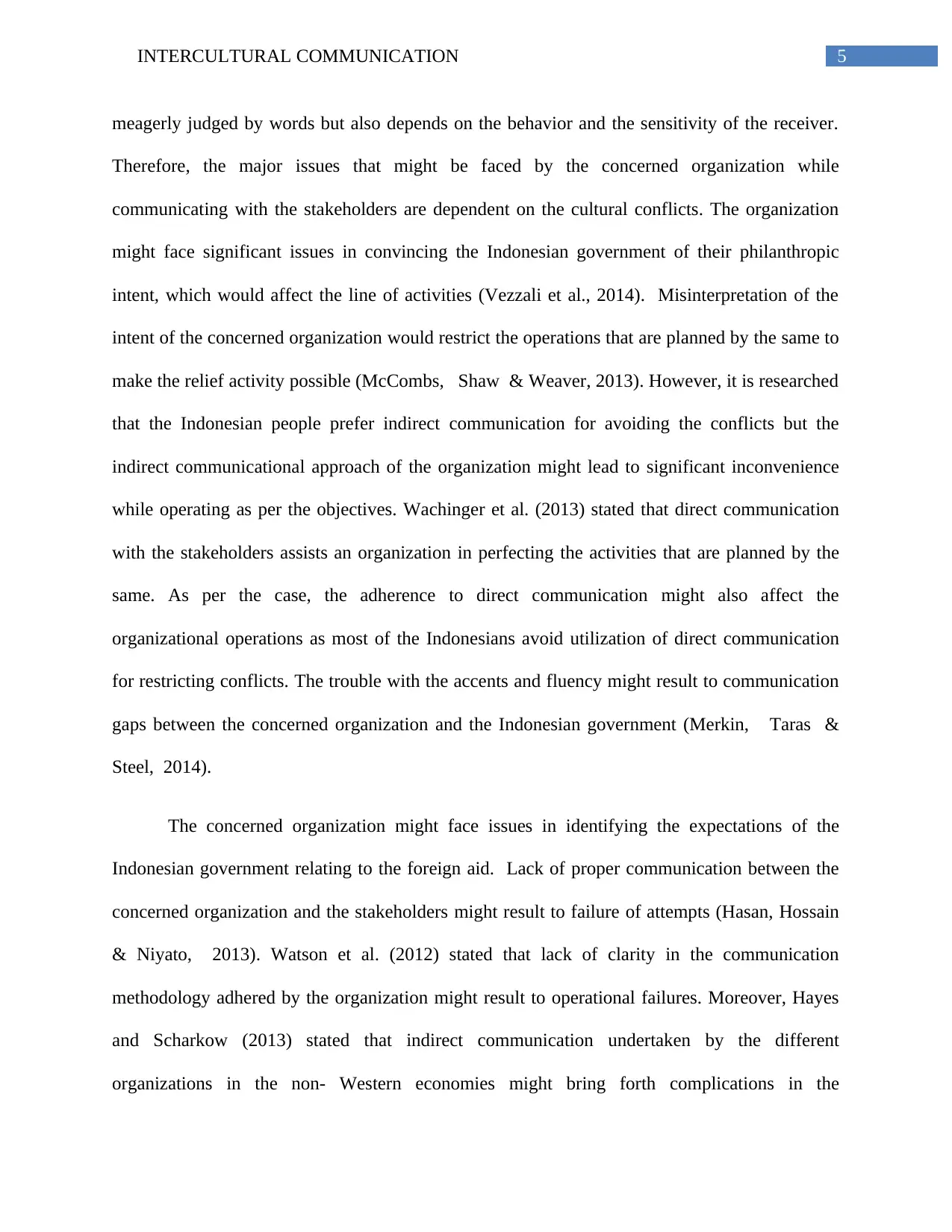
5INTERCULTURAL COMMUNICATION
meagerly judged by words but also depends on the behavior and the sensitivity of the receiver.
Therefore, the major issues that might be faced by the concerned organization while
communicating with the stakeholders are dependent on the cultural conflicts. The organization
might face significant issues in convincing the Indonesian government of their philanthropic
intent, which would affect the line of activities (Vezzali et al., 2014). Misinterpretation of the
intent of the concerned organization would restrict the operations that are planned by the same to
make the relief activity possible (McCombs, Shaw & Weaver, 2013). However, it is researched
that the Indonesian people prefer indirect communication for avoiding the conflicts but the
indirect communicational approach of the organization might lead to significant inconvenience
while operating as per the objectives. Wachinger et al. (2013) stated that direct communication
with the stakeholders assists an organization in perfecting the activities that are planned by the
same. As per the case, the adherence to direct communication might also affect the
organizational operations as most of the Indonesians avoid utilization of direct communication
for restricting conflicts. The trouble with the accents and fluency might result to communication
gaps between the concerned organization and the Indonesian government (Merkin, Taras &
Steel, 2014).
The concerned organization might face issues in identifying the expectations of the
Indonesian government relating to the foreign aid. Lack of proper communication between the
concerned organization and the stakeholders might result to failure of attempts (Hasan, Hossain
& Niyato, 2013). Watson et al. (2012) stated that lack of clarity in the communication
methodology adhered by the organization might result to operational failures. Moreover, Hayes
and Scharkow (2013) stated that indirect communication undertaken by the different
organizations in the non- Western economies might bring forth complications in the
meagerly judged by words but also depends on the behavior and the sensitivity of the receiver.
Therefore, the major issues that might be faced by the concerned organization while
communicating with the stakeholders are dependent on the cultural conflicts. The organization
might face significant issues in convincing the Indonesian government of their philanthropic
intent, which would affect the line of activities (Vezzali et al., 2014). Misinterpretation of the
intent of the concerned organization would restrict the operations that are planned by the same to
make the relief activity possible (McCombs, Shaw & Weaver, 2013). However, it is researched
that the Indonesian people prefer indirect communication for avoiding the conflicts but the
indirect communicational approach of the organization might lead to significant inconvenience
while operating as per the objectives. Wachinger et al. (2013) stated that direct communication
with the stakeholders assists an organization in perfecting the activities that are planned by the
same. As per the case, the adherence to direct communication might also affect the
organizational operations as most of the Indonesians avoid utilization of direct communication
for restricting conflicts. The trouble with the accents and fluency might result to communication
gaps between the concerned organization and the Indonesian government (Merkin, Taras &
Steel, 2014).
The concerned organization might face issues in identifying the expectations of the
Indonesian government relating to the foreign aid. Lack of proper communication between the
concerned organization and the stakeholders might result to failure of attempts (Hasan, Hossain
& Niyato, 2013). Watson et al. (2012) stated that lack of clarity in the communication
methodology adhered by the organization might result to operational failures. Moreover, Hayes
and Scharkow (2013) stated that indirect communication undertaken by the different
organizations in the non- Western economies might bring forth complications in the
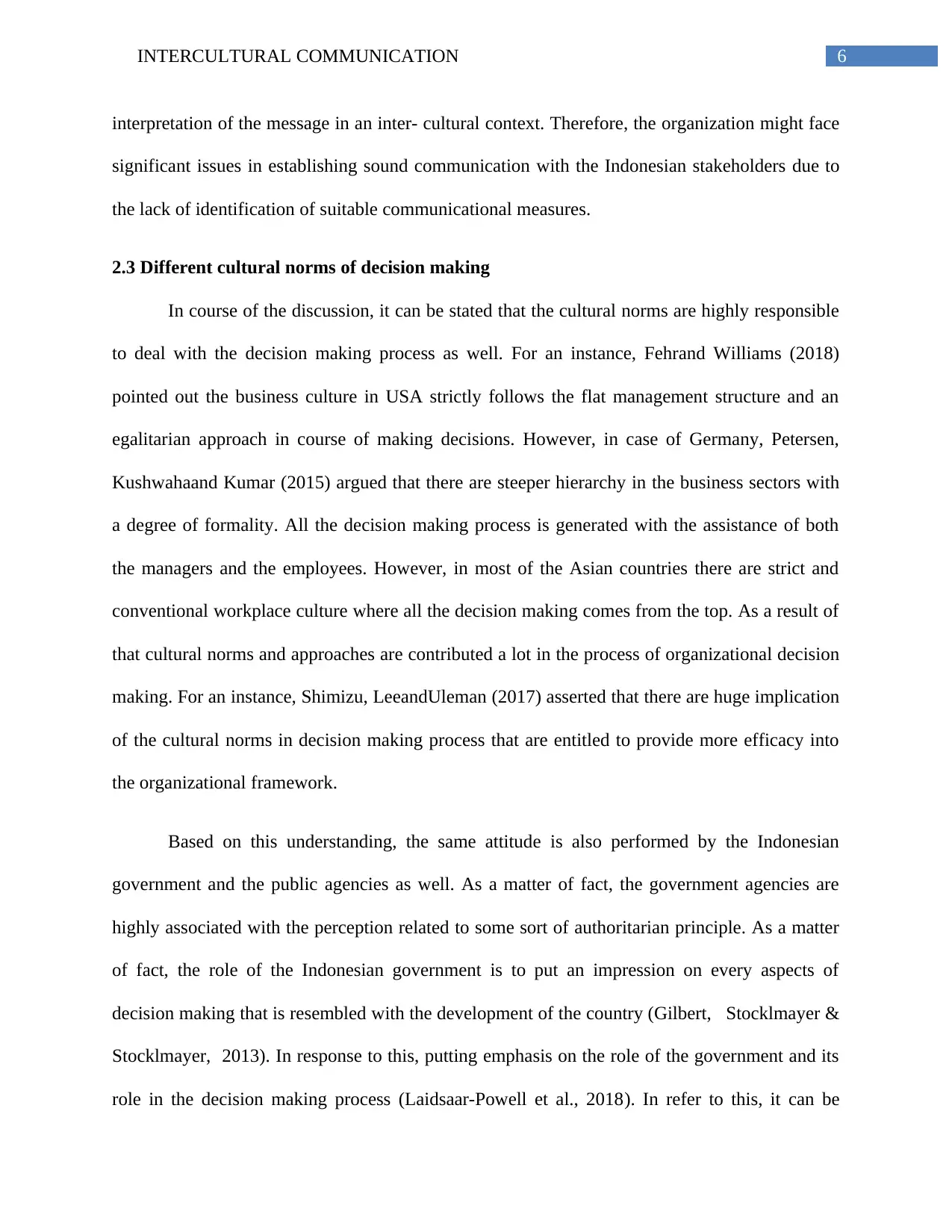
6INTERCULTURAL COMMUNICATION
interpretation of the message in an inter- cultural context. Therefore, the organization might face
significant issues in establishing sound communication with the Indonesian stakeholders due to
the lack of identification of suitable communicational measures.
2.3 Different cultural norms of decision making
In course of the discussion, it can be stated that the cultural norms are highly responsible
to deal with the decision making process as well. For an instance, Fehrand Williams (2018)
pointed out the business culture in USA strictly follows the flat management structure and an
egalitarian approach in course of making decisions. However, in case of Germany, Petersen,
Kushwahaand Kumar (2015) argued that there are steeper hierarchy in the business sectors with
a degree of formality. All the decision making process is generated with the assistance of both
the managers and the employees. However, in most of the Asian countries there are strict and
conventional workplace culture where all the decision making comes from the top. As a result of
that cultural norms and approaches are contributed a lot in the process of organizational decision
making. For an instance, Shimizu, LeeandUleman (2017) asserted that there are huge implication
of the cultural norms in decision making process that are entitled to provide more efficacy into
the organizational framework.
Based on this understanding, the same attitude is also performed by the Indonesian
government and the public agencies as well. As a matter of fact, the government agencies are
highly associated with the perception related to some sort of authoritarian principle. As a matter
of fact, the role of the Indonesian government is to put an impression on every aspects of
decision making that is resembled with the development of the country (Gilbert, Stocklmayer &
Stocklmayer, 2013). In response to this, putting emphasis on the role of the government and its
role in the decision making process (Laidsaar-Powell et al., 2018). In refer to this, it can be
interpretation of the message in an inter- cultural context. Therefore, the organization might face
significant issues in establishing sound communication with the Indonesian stakeholders due to
the lack of identification of suitable communicational measures.
2.3 Different cultural norms of decision making
In course of the discussion, it can be stated that the cultural norms are highly responsible
to deal with the decision making process as well. For an instance, Fehrand Williams (2018)
pointed out the business culture in USA strictly follows the flat management structure and an
egalitarian approach in course of making decisions. However, in case of Germany, Petersen,
Kushwahaand Kumar (2015) argued that there are steeper hierarchy in the business sectors with
a degree of formality. All the decision making process is generated with the assistance of both
the managers and the employees. However, in most of the Asian countries there are strict and
conventional workplace culture where all the decision making comes from the top. As a result of
that cultural norms and approaches are contributed a lot in the process of organizational decision
making. For an instance, Shimizu, LeeandUleman (2017) asserted that there are huge implication
of the cultural norms in decision making process that are entitled to provide more efficacy into
the organizational framework.
Based on this understanding, the same attitude is also performed by the Indonesian
government and the public agencies as well. As a matter of fact, the government agencies are
highly associated with the perception related to some sort of authoritarian principle. As a matter
of fact, the role of the Indonesian government is to put an impression on every aspects of
decision making that is resembled with the development of the country (Gilbert, Stocklmayer &
Stocklmayer, 2013). In response to this, putting emphasis on the role of the government and its
role in the decision making process (Laidsaar-Powell et al., 2018). In refer to this, it can be
Paraphrase This Document
Need a fresh take? Get an instant paraphrase of this document with our AI Paraphraser
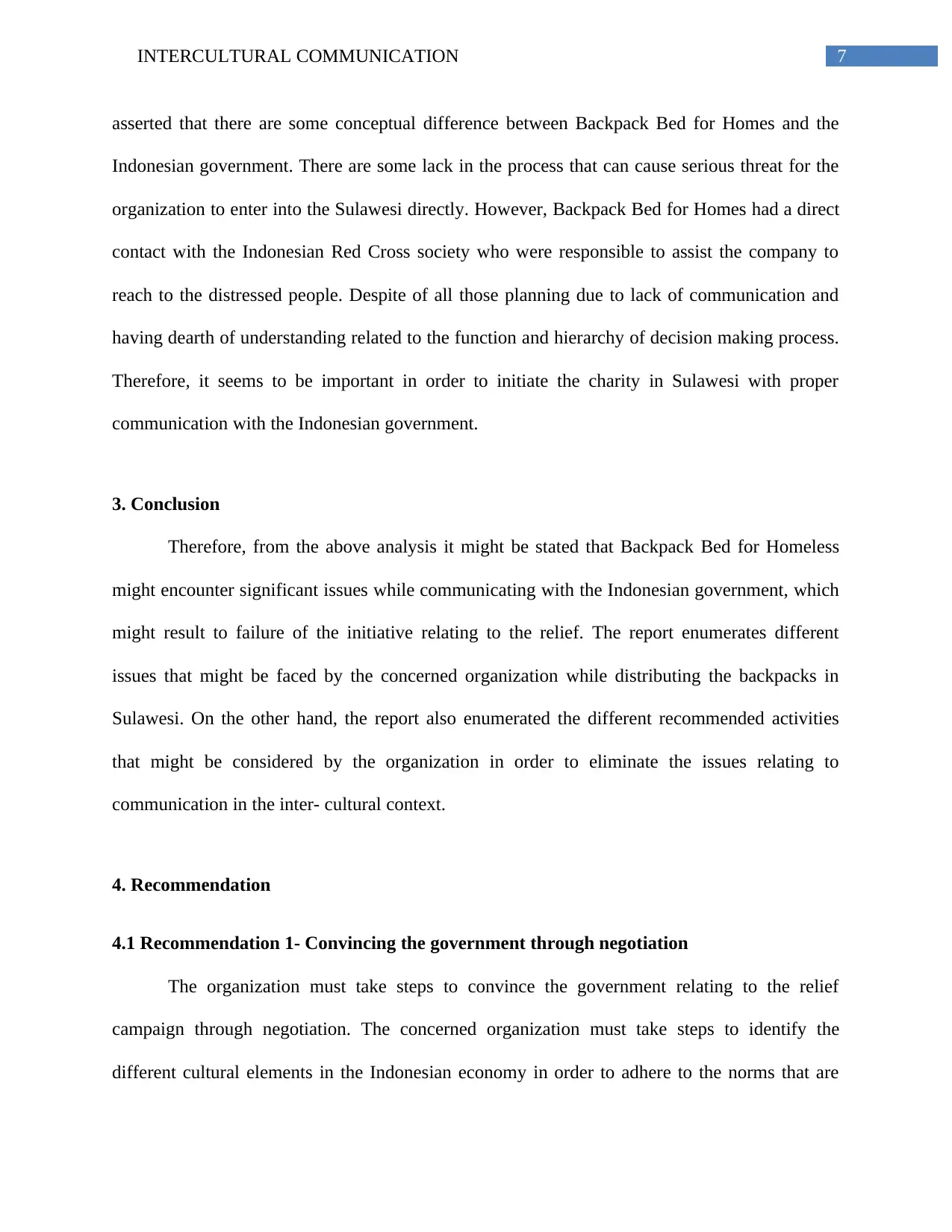
7INTERCULTURAL COMMUNICATION
asserted that there are some conceptual difference between Backpack Bed for Homes and the
Indonesian government. There are some lack in the process that can cause serious threat for the
organization to enter into the Sulawesi directly. However, Backpack Bed for Homes had a direct
contact with the Indonesian Red Cross society who were responsible to assist the company to
reach to the distressed people. Despite of all those planning due to lack of communication and
having dearth of understanding related to the function and hierarchy of decision making process.
Therefore, it seems to be important in order to initiate the charity in Sulawesi with proper
communication with the Indonesian government.
3. Conclusion
Therefore, from the above analysis it might be stated that Backpack Bed for Homeless
might encounter significant issues while communicating with the Indonesian government, which
might result to failure of the initiative relating to the relief. The report enumerates different
issues that might be faced by the concerned organization while distributing the backpacks in
Sulawesi. On the other hand, the report also enumerated the different recommended activities
that might be considered by the organization in order to eliminate the issues relating to
communication in the inter- cultural context.
4. Recommendation
4.1 Recommendation 1- Convincing the government through negotiation
The organization must take steps to convince the government relating to the relief
campaign through negotiation. The concerned organization must take steps to identify the
different cultural elements in the Indonesian economy in order to adhere to the norms that are
asserted that there are some conceptual difference between Backpack Bed for Homes and the
Indonesian government. There are some lack in the process that can cause serious threat for the
organization to enter into the Sulawesi directly. However, Backpack Bed for Homes had a direct
contact with the Indonesian Red Cross society who were responsible to assist the company to
reach to the distressed people. Despite of all those planning due to lack of communication and
having dearth of understanding related to the function and hierarchy of decision making process.
Therefore, it seems to be important in order to initiate the charity in Sulawesi with proper
communication with the Indonesian government.
3. Conclusion
Therefore, from the above analysis it might be stated that Backpack Bed for Homeless
might encounter significant issues while communicating with the Indonesian government, which
might result to failure of the initiative relating to the relief. The report enumerates different
issues that might be faced by the concerned organization while distributing the backpacks in
Sulawesi. On the other hand, the report also enumerated the different recommended activities
that might be considered by the organization in order to eliminate the issues relating to
communication in the inter- cultural context.
4. Recommendation
4.1 Recommendation 1- Convincing the government through negotiation
The organization must take steps to convince the government relating to the relief
campaign through negotiation. The concerned organization must take steps to identify the
different cultural elements in the Indonesian economy in order to adhere to the norms that are
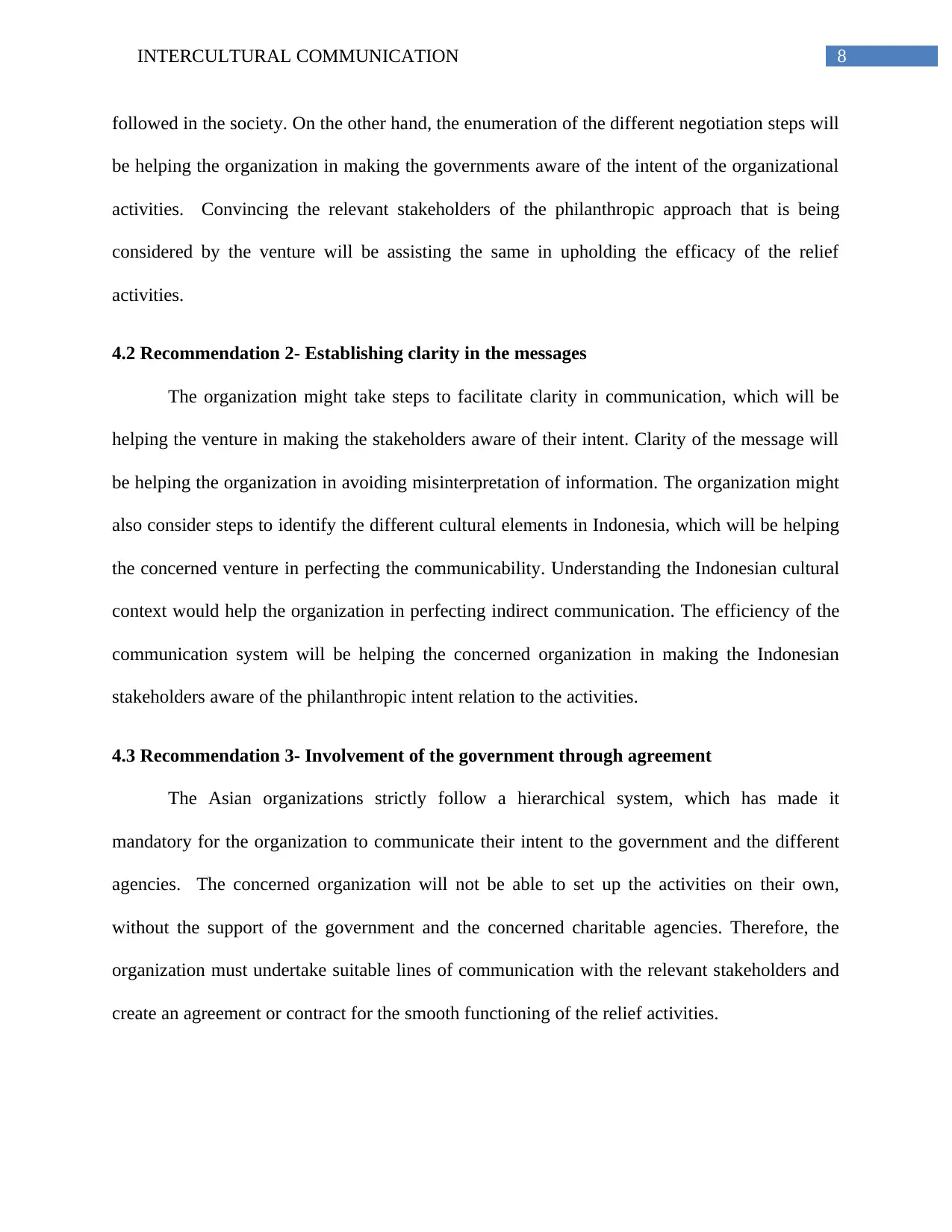
8INTERCULTURAL COMMUNICATION
followed in the society. On the other hand, the enumeration of the different negotiation steps will
be helping the organization in making the governments aware of the intent of the organizational
activities. Convincing the relevant stakeholders of the philanthropic approach that is being
considered by the venture will be assisting the same in upholding the efficacy of the relief
activities.
4.2 Recommendation 2- Establishing clarity in the messages
The organization might take steps to facilitate clarity in communication, which will be
helping the venture in making the stakeholders aware of their intent. Clarity of the message will
be helping the organization in avoiding misinterpretation of information. The organization might
also consider steps to identify the different cultural elements in Indonesia, which will be helping
the concerned venture in perfecting the communicability. Understanding the Indonesian cultural
context would help the organization in perfecting indirect communication. The efficiency of the
communication system will be helping the concerned organization in making the Indonesian
stakeholders aware of the philanthropic intent relation to the activities.
4.3 Recommendation 3- Involvement of the government through agreement
The Asian organizations strictly follow a hierarchical system, which has made it
mandatory for the organization to communicate their intent to the government and the different
agencies. The concerned organization will not be able to set up the activities on their own,
without the support of the government and the concerned charitable agencies. Therefore, the
organization must undertake suitable lines of communication with the relevant stakeholders and
create an agreement or contract for the smooth functioning of the relief activities.
followed in the society. On the other hand, the enumeration of the different negotiation steps will
be helping the organization in making the governments aware of the intent of the organizational
activities. Convincing the relevant stakeholders of the philanthropic approach that is being
considered by the venture will be assisting the same in upholding the efficacy of the relief
activities.
4.2 Recommendation 2- Establishing clarity in the messages
The organization might take steps to facilitate clarity in communication, which will be
helping the venture in making the stakeholders aware of their intent. Clarity of the message will
be helping the organization in avoiding misinterpretation of information. The organization might
also consider steps to identify the different cultural elements in Indonesia, which will be helping
the concerned venture in perfecting the communicability. Understanding the Indonesian cultural
context would help the organization in perfecting indirect communication. The efficiency of the
communication system will be helping the concerned organization in making the Indonesian
stakeholders aware of the philanthropic intent relation to the activities.
4.3 Recommendation 3- Involvement of the government through agreement
The Asian organizations strictly follow a hierarchical system, which has made it
mandatory for the organization to communicate their intent to the government and the different
agencies. The concerned organization will not be able to set up the activities on their own,
without the support of the government and the concerned charitable agencies. Therefore, the
organization must undertake suitable lines of communication with the relevant stakeholders and
create an agreement or contract for the smooth functioning of the relief activities.
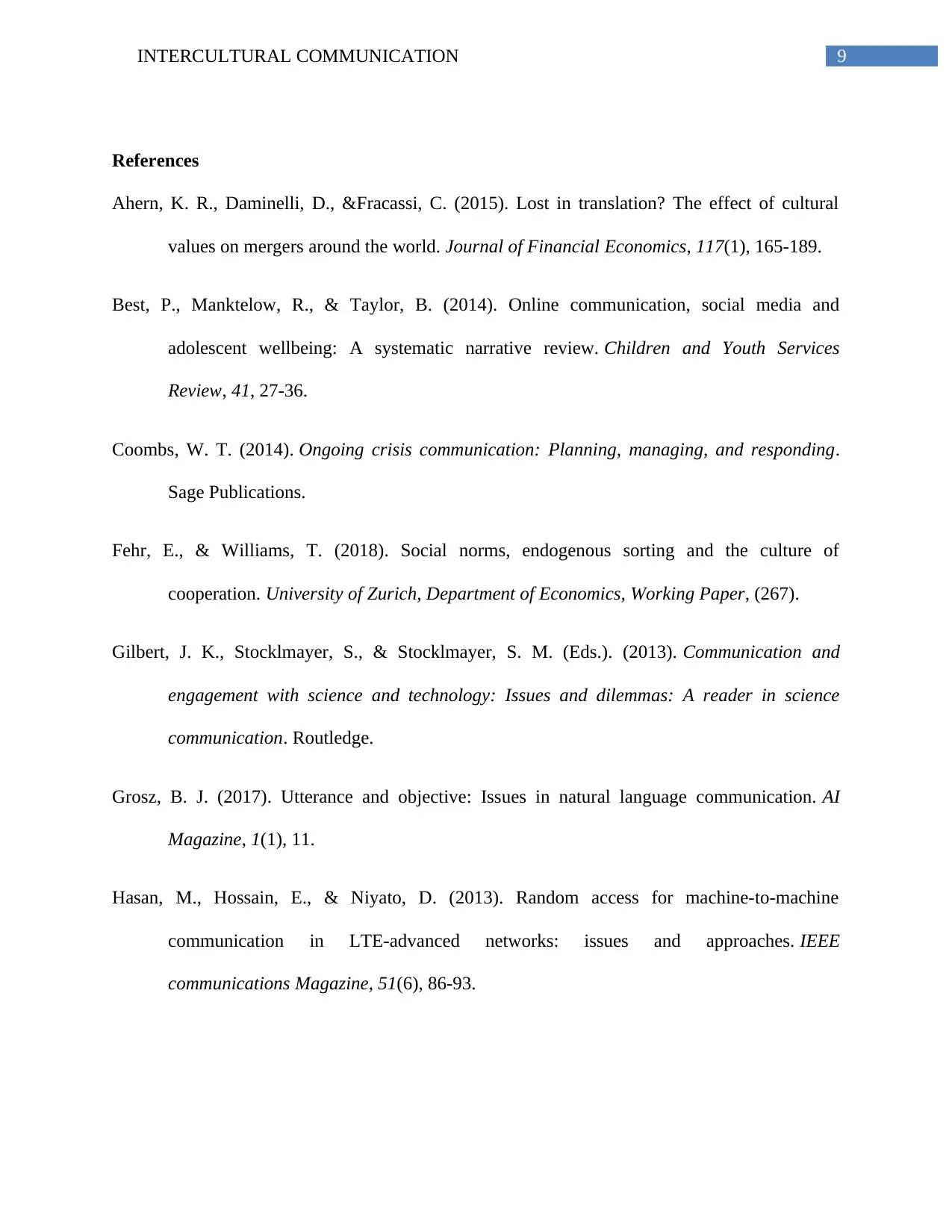
9INTERCULTURAL COMMUNICATION
References
Ahern, K. R., Daminelli, D., &Fracassi, C. (2015). Lost in translation? The effect of cultural
values on mergers around the world. Journal of Financial Economics, 117(1), 165-189.
Best, P., Manktelow, R., & Taylor, B. (2014). Online communication, social media and
adolescent wellbeing: A systematic narrative review. Children and Youth Services
Review, 41, 27-36.
Coombs, W. T. (2014). Ongoing crisis communication: Planning, managing, and responding.
Sage Publications.
Fehr, E., & Williams, T. (2018). Social norms, endogenous sorting and the culture of
cooperation. University of Zurich, Department of Economics, Working Paper, (267).
Gilbert, J. K., Stocklmayer, S., & Stocklmayer, S. M. (Eds.). (2013). Communication and
engagement with science and technology: Issues and dilemmas: A reader in science
communication. Routledge.
Grosz, B. J. (2017). Utterance and objective: Issues in natural language communication. AI
Magazine, 1(1), 11.
Hasan, M., Hossain, E., & Niyato, D. (2013). Random access for machine-to-machine
communication in LTE-advanced networks: issues and approaches. IEEE
communications Magazine, 51(6), 86-93.
References
Ahern, K. R., Daminelli, D., &Fracassi, C. (2015). Lost in translation? The effect of cultural
values on mergers around the world. Journal of Financial Economics, 117(1), 165-189.
Best, P., Manktelow, R., & Taylor, B. (2014). Online communication, social media and
adolescent wellbeing: A systematic narrative review. Children and Youth Services
Review, 41, 27-36.
Coombs, W. T. (2014). Ongoing crisis communication: Planning, managing, and responding.
Sage Publications.
Fehr, E., & Williams, T. (2018). Social norms, endogenous sorting and the culture of
cooperation. University of Zurich, Department of Economics, Working Paper, (267).
Gilbert, J. K., Stocklmayer, S., & Stocklmayer, S. M. (Eds.). (2013). Communication and
engagement with science and technology: Issues and dilemmas: A reader in science
communication. Routledge.
Grosz, B. J. (2017). Utterance and objective: Issues in natural language communication. AI
Magazine, 1(1), 11.
Hasan, M., Hossain, E., & Niyato, D. (2013). Random access for machine-to-machine
communication in LTE-advanced networks: issues and approaches. IEEE
communications Magazine, 51(6), 86-93.
Secure Best Marks with AI Grader
Need help grading? Try our AI Grader for instant feedback on your assignments.
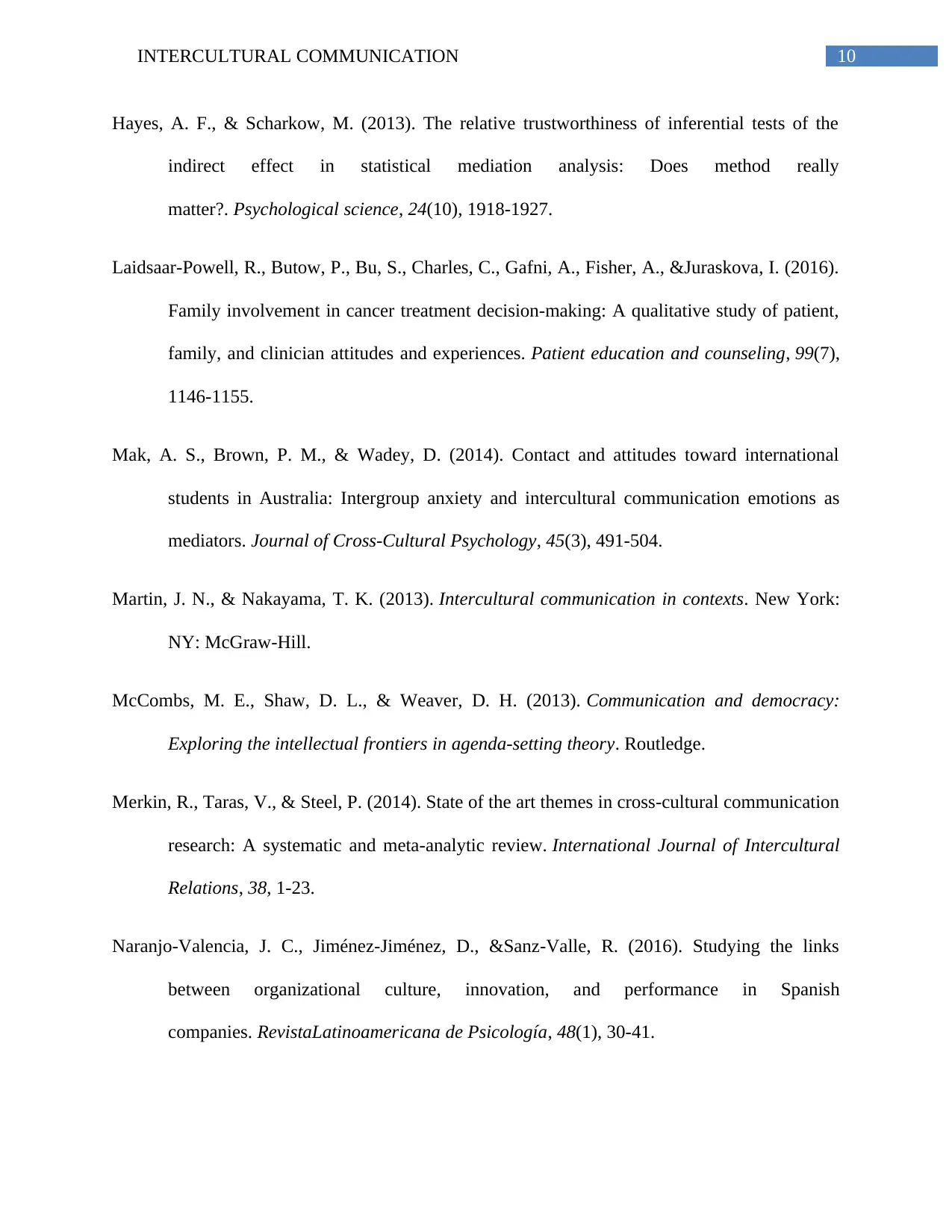
10INTERCULTURAL COMMUNICATION
Hayes, A. F., & Scharkow, M. (2013). The relative trustworthiness of inferential tests of the
indirect effect in statistical mediation analysis: Does method really
matter?. Psychological science, 24(10), 1918-1927.
Laidsaar-Powell, R., Butow, P., Bu, S., Charles, C., Gafni, A., Fisher, A., &Juraskova, I. (2016).
Family involvement in cancer treatment decision-making: A qualitative study of patient,
family, and clinician attitudes and experiences. Patient education and counseling, 99(7),
1146-1155.
Mak, A. S., Brown, P. M., & Wadey, D. (2014). Contact and attitudes toward international
students in Australia: Intergroup anxiety and intercultural communication emotions as
mediators. Journal of Cross-Cultural Psychology, 45(3), 491-504.
Martin, J. N., & Nakayama, T. K. (2013). Intercultural communication in contexts. New York:
NY: McGraw-Hill.
McCombs, M. E., Shaw, D. L., & Weaver, D. H. (2013). Communication and democracy:
Exploring the intellectual frontiers in agenda-setting theory. Routledge.
Merkin, R., Taras, V., & Steel, P. (2014). State of the art themes in cross-cultural communication
research: A systematic and meta-analytic review. International Journal of Intercultural
Relations, 38, 1-23.
Naranjo-Valencia, J. C., Jiménez-Jiménez, D., &Sanz-Valle, R. (2016). Studying the links
between organizational culture, innovation, and performance in Spanish
companies. RevistaLatinoamericana de Psicología, 48(1), 30-41.
Hayes, A. F., & Scharkow, M. (2013). The relative trustworthiness of inferential tests of the
indirect effect in statistical mediation analysis: Does method really
matter?. Psychological science, 24(10), 1918-1927.
Laidsaar-Powell, R., Butow, P., Bu, S., Charles, C., Gafni, A., Fisher, A., &Juraskova, I. (2016).
Family involvement in cancer treatment decision-making: A qualitative study of patient,
family, and clinician attitudes and experiences. Patient education and counseling, 99(7),
1146-1155.
Mak, A. S., Brown, P. M., & Wadey, D. (2014). Contact and attitudes toward international
students in Australia: Intergroup anxiety and intercultural communication emotions as
mediators. Journal of Cross-Cultural Psychology, 45(3), 491-504.
Martin, J. N., & Nakayama, T. K. (2013). Intercultural communication in contexts. New York:
NY: McGraw-Hill.
McCombs, M. E., Shaw, D. L., & Weaver, D. H. (2013). Communication and democracy:
Exploring the intellectual frontiers in agenda-setting theory. Routledge.
Merkin, R., Taras, V., & Steel, P. (2014). State of the art themes in cross-cultural communication
research: A systematic and meta-analytic review. International Journal of Intercultural
Relations, 38, 1-23.
Naranjo-Valencia, J. C., Jiménez-Jiménez, D., &Sanz-Valle, R. (2016). Studying the links
between organizational culture, innovation, and performance in Spanish
companies. RevistaLatinoamericana de Psicología, 48(1), 30-41.
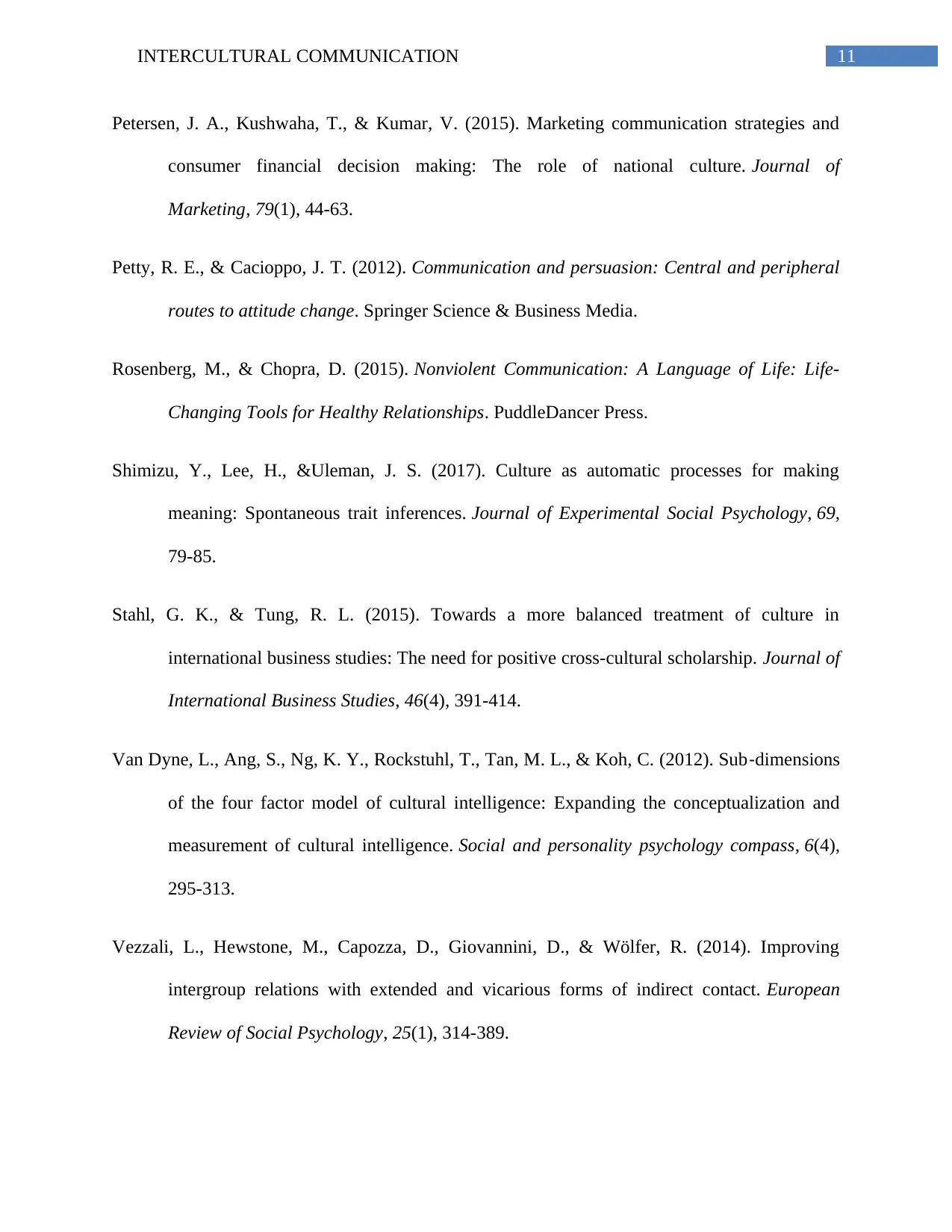
11INTERCULTURAL COMMUNICATION
Petersen, J. A., Kushwaha, T., & Kumar, V. (2015). Marketing communication strategies and
consumer financial decision making: The role of national culture. Journal of
Marketing, 79(1), 44-63.
Petty, R. E., & Cacioppo, J. T. (2012). Communication and persuasion: Central and peripheral
routes to attitude change. Springer Science & Business Media.
Rosenberg, M., & Chopra, D. (2015). Nonviolent Communication: A Language of Life: Life-
Changing Tools for Healthy Relationships. PuddleDancer Press.
Shimizu, Y., Lee, H., &Uleman, J. S. (2017). Culture as automatic processes for making
meaning: Spontaneous trait inferences. Journal of Experimental Social Psychology, 69,
79-85.
Stahl, G. K., & Tung, R. L. (2015). Towards a more balanced treatment of culture in
international business studies: The need for positive cross-cultural scholarship. Journal of
International Business Studies, 46(4), 391-414.
Van Dyne, L., Ang, S., Ng, K. Y., Rockstuhl, T., Tan, M. L., & Koh, C. (2012). Sub‐dimensions
of the four factor model of cultural intelligence: Expanding the conceptualization and
measurement of cultural intelligence. Social and personality psychology compass, 6(4),
295-313.
Vezzali, L., Hewstone, M., Capozza, D., Giovannini, D., & Wölfer, R. (2014). Improving
intergroup relations with extended and vicarious forms of indirect contact. European
Review of Social Psychology, 25(1), 314-389.
Petersen, J. A., Kushwaha, T., & Kumar, V. (2015). Marketing communication strategies and
consumer financial decision making: The role of national culture. Journal of
Marketing, 79(1), 44-63.
Petty, R. E., & Cacioppo, J. T. (2012). Communication and persuasion: Central and peripheral
routes to attitude change. Springer Science & Business Media.
Rosenberg, M., & Chopra, D. (2015). Nonviolent Communication: A Language of Life: Life-
Changing Tools for Healthy Relationships. PuddleDancer Press.
Shimizu, Y., Lee, H., &Uleman, J. S. (2017). Culture as automatic processes for making
meaning: Spontaneous trait inferences. Journal of Experimental Social Psychology, 69,
79-85.
Stahl, G. K., & Tung, R. L. (2015). Towards a more balanced treatment of culture in
international business studies: The need for positive cross-cultural scholarship. Journal of
International Business Studies, 46(4), 391-414.
Van Dyne, L., Ang, S., Ng, K. Y., Rockstuhl, T., Tan, M. L., & Koh, C. (2012). Sub‐dimensions
of the four factor model of cultural intelligence: Expanding the conceptualization and
measurement of cultural intelligence. Social and personality psychology compass, 6(4),
295-313.
Vezzali, L., Hewstone, M., Capozza, D., Giovannini, D., & Wölfer, R. (2014). Improving
intergroup relations with extended and vicarious forms of indirect contact. European
Review of Social Psychology, 25(1), 314-389.
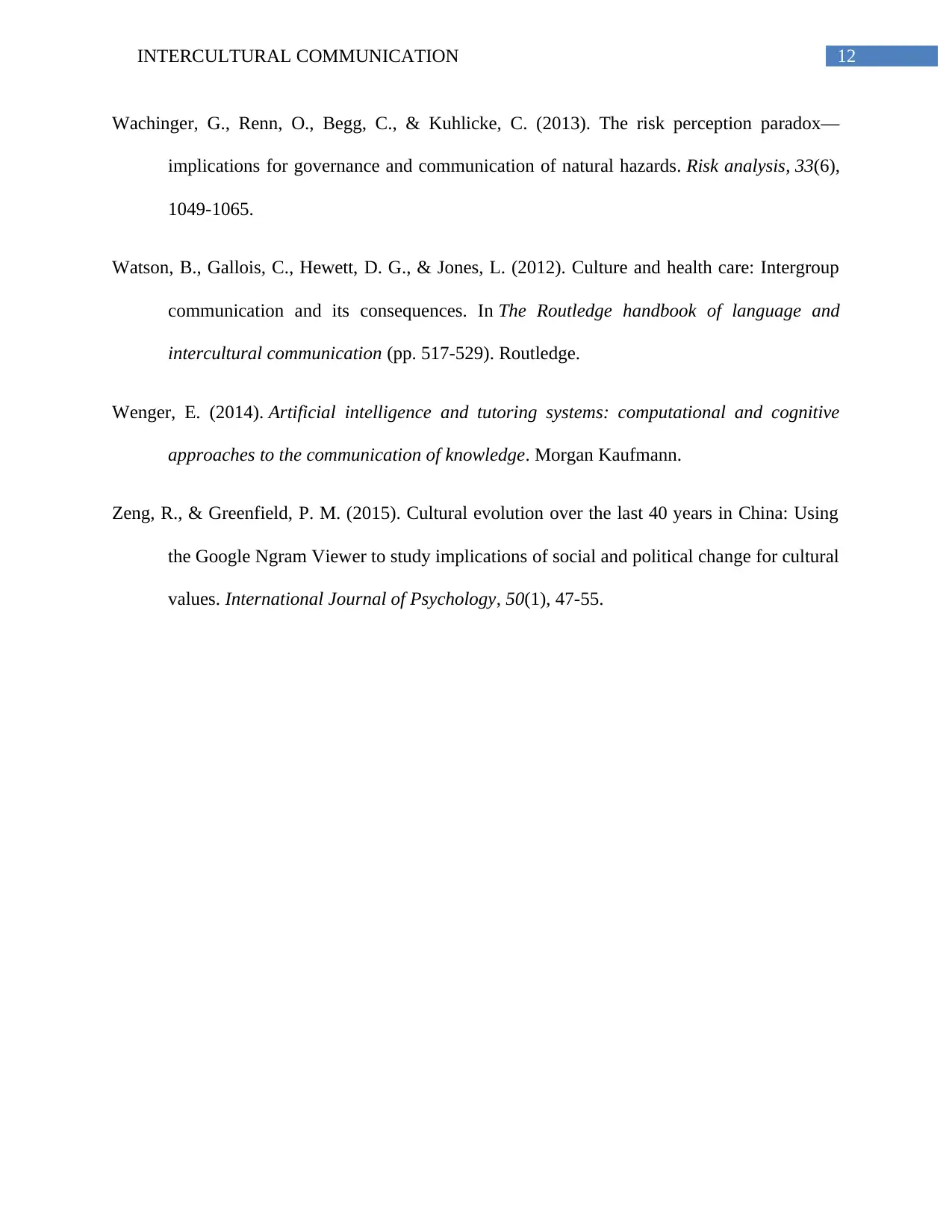
12INTERCULTURAL COMMUNICATION
Wachinger, G., Renn, O., Begg, C., & Kuhlicke, C. (2013). The risk perception paradox—
implications for governance and communication of natural hazards. Risk analysis, 33(6),
1049-1065.
Watson, B., Gallois, C., Hewett, D. G., & Jones, L. (2012). Culture and health care: Intergroup
communication and its consequences. In The Routledge handbook of language and
intercultural communication (pp. 517-529). Routledge.
Wenger, E. (2014). Artificial intelligence and tutoring systems: computational and cognitive
approaches to the communication of knowledge. Morgan Kaufmann.
Zeng, R., & Greenfield, P. M. (2015). Cultural evolution over the last 40 years in China: Using
the Google Ngram Viewer to study implications of social and political change for cultural
values. International Journal of Psychology, 50(1), 47-55.
Wachinger, G., Renn, O., Begg, C., & Kuhlicke, C. (2013). The risk perception paradox—
implications for governance and communication of natural hazards. Risk analysis, 33(6),
1049-1065.
Watson, B., Gallois, C., Hewett, D. G., & Jones, L. (2012). Culture and health care: Intergroup
communication and its consequences. In The Routledge handbook of language and
intercultural communication (pp. 517-529). Routledge.
Wenger, E. (2014). Artificial intelligence and tutoring systems: computational and cognitive
approaches to the communication of knowledge. Morgan Kaufmann.
Zeng, R., & Greenfield, P. M. (2015). Cultural evolution over the last 40 years in China: Using
the Google Ngram Viewer to study implications of social and political change for cultural
values. International Journal of Psychology, 50(1), 47-55.
1 out of 13
Related Documents
Your All-in-One AI-Powered Toolkit for Academic Success.
+13062052269
info@desklib.com
Available 24*7 on WhatsApp / Email
![[object Object]](/_next/static/media/star-bottom.7253800d.svg)
Unlock your academic potential
© 2024 | Zucol Services PVT LTD | All rights reserved.




